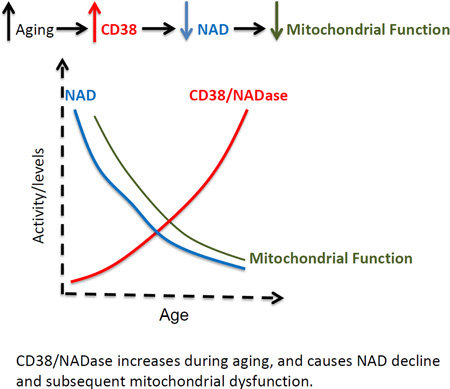Learning complex information is hard. When we put things in story form, it’s much easier to learn and remember. NAD+ precursers are at the heart of interventions for fighting age-related diseases and aging itself. A recent research study discusses NAD+ in a rat model of kidney disease and a cell culture.
The Characters
The setting for our main story is the kidney of a diabetic rat. The characters in our story are these:
- Mitochondrial Oxidative Stress: Reactive oxygen species, aka free radicals are capable of destroying the energy-producing (ATP-generating) infrastructure in the mitochondria of the nephrons.
- NAD+: NAD+ is a critical energy molecule that provides the Sirtuins with their needed fuel.
- Sirt3: This is one of seven sirtuin enzymes that alter proteins to manage essential biological processes such as aging and metabolism. By removing acetyl groups from proteins, the process of deacetylation, Sirt3 indirectly influences gene expression, guiding cellular repair functions. Located mainly in the mitochondria, Sirt3 helps regulate energy production and stress response.
- CD38: This is an enzyme that breaks down NAD+, a vital molecule for cellular energy and repair, and its activity is linked to several health conditions such as inflammation and metabolic disorders.
- Apigenin: This is a compound in fruits and vegetables that can inhibit CD38, an enzyme that degrades NAD+, thereby improving cell health and fighting inflammation and oxidative stress.
The Story
Once upon a time, in the tiny yet bustling world inside our bodies, there lived a city of countless cells, home to millions of intricate activities. The city’s name was Zucker Diabetic Fatty Rat Kidney, or ZDFRK for short, and it was struggling. A menacing villain known as Mitochondrial Oxidative Stress was causing havoc, contributing significantly to the development of a disease known as diabetic kidney disease, or DKD.
The citizens of ZDFRK knew that a valuable substance, called NAD+, and its diligent partner, the Sirt3 repair protein, were essential to combat the villain. Unfortunately, the levels of NAD+ were dwindling, and Sirt3 repair activity was weakening. This was due to the increasing numbers in the villain army named CD38, notorious for breaking down NAD+.
In the midst of this crisis, a hero emerged from the world of scientific research: Apigenin, a powerful inhibitor of CD38. Apigenin was sent on a mission to rescue the ailing city of ZDFRK. With its CD38 inhibitory powers, Apigenin could potentially restore the balance of NAD+ and Sirt3 and ultimately fight off the nefarious villain, Mitochondrial Oxidative Stress.
In the beginning, Apigenin faced daunting challenges. It found the city of ZDFRK filled with damaged buildings (tubular cells) and filled with a dark cloud of inflammation. But undeterred, Apigenin worked hard, and to everyone’s relief, it significantly reduced these damages. It subdued CD38, restored NAD+ levels, and reignited the activity of Sirt3.
In a parallel universe, a similar city named HK-2, which was also suffering from high glucose levels, saw similar miracles. When Apigenin or CD38 knockdown came to town, they were able to increase NAD+ levels and boost Sirt3 activity.
The success of Apigenin in both cities showed how important CD38 was in the struggle against DKD. By inhibiting Sirt3 and increasing the stress in the city’s mitochondria, CD38 played a significant role in the disease’s development. The heroic actions of Apigenin highlighted the potential of countering CD38 to combat DKD.
And so, the story of Apigenin continues, with hopes of more victories in the fight against diabetic kidney disease. The cells in the cities of ZDFRK and HK-2 will always remember Apigenin, the hero that came to their rescue in a time of crisis.
The Study Described in the Story
In a rat model of kidney disease, researchers studied apigenin, a CD38 inhibitor, to probe the influence of CD38 on diabetic kidney disease (DKD). Researchers noted a significant mitigation in renal injury markers, including tubulointerstitial fibrosis, tubular cellular damage, and the expression of pro-inflammatory genes in diabetic rat models following apigenin administration. In tandem, apigenin treatment also led to a down-regulation in CD38 expression and an upsurge in the intracellular NAD+/NADH ratio and Sirt3-facilitated mitochondrial antioxidative enzyme activity in the diabetic rats’ kidneys.
This fits into what is previously known about DKD. Mitochondrial oxidative stress serves as a pivotal contributor to the onset and progression of DKD. In earlier studies conducted on Zucker diabetic fatty rats, researchers highlighted a correlation between kidney-specific mitochondrial oxidative stress, a diminished intracellular NAD+/NADH ratio, subdued Sirt3 activity, and an escalation in CD38 expression, an enzyme pivotal for NAD+ degradation.
Complementing this, researchers conducted in vitro study that demonstrated an augmentation in the NAD+/NADH ratio and Sirt3 activity in renal proximal tubular HK-2 cells under high-glucose conditions, following either the inhibition of CD38 activity by apigenin or CD38 knockdown.
Collectively, these findings underscore that CD38, by its inhibitory effect on Sirt3 activity and consequent amplification of mitochondrial oxidative stress in renal tubular cells, exerts a critical role in the pathogenesis of DKD. [PMC7343471]

Next Steps
No one would argue that animal models are not human trials, and we need human trials to confirm these findings. The problem is that we don’t have them yet and we won’t have them in time to help our clients dealing with kidney disease today. The patient’s decision of whether or not to act on this research will often boil down to an individual’s own very personal risk-reward calculations. But the research itself very clearly indicates that Apigenin can play a beneficial role in the cellular metabolism in diabetic kidney disease.
Educate patients on the risks of using Amazon for supplements: Read this to see some of the reasons it’s just not a trustworthy place to send our patients for supplements. The untrustworthy nature of the entire supplement space was the whole reason why Supplement-Sciences.com was created as a resource for dietitians and our patients. Click the button to find out more.

 Scan Me!
Scan Me!




